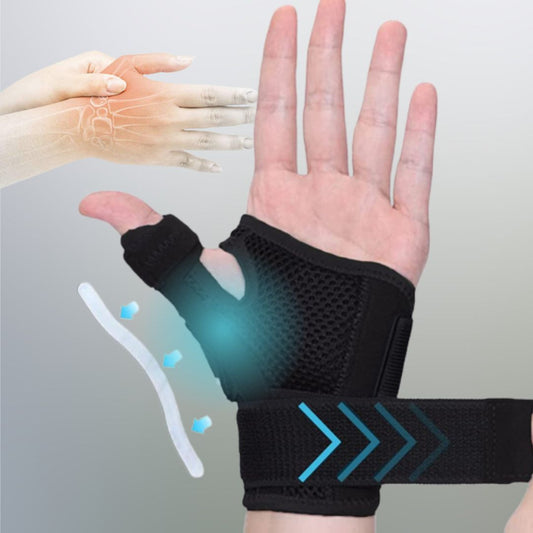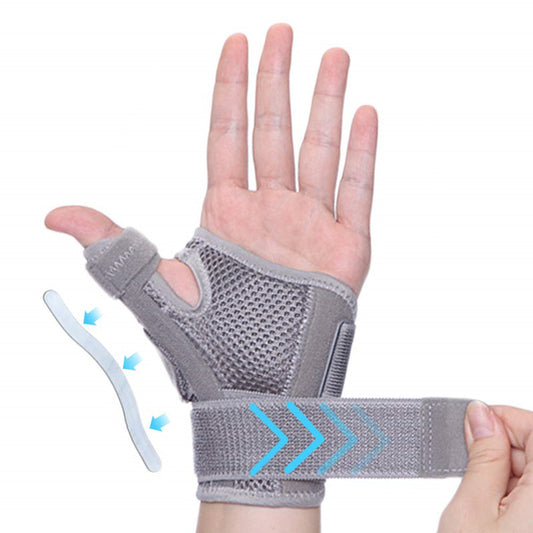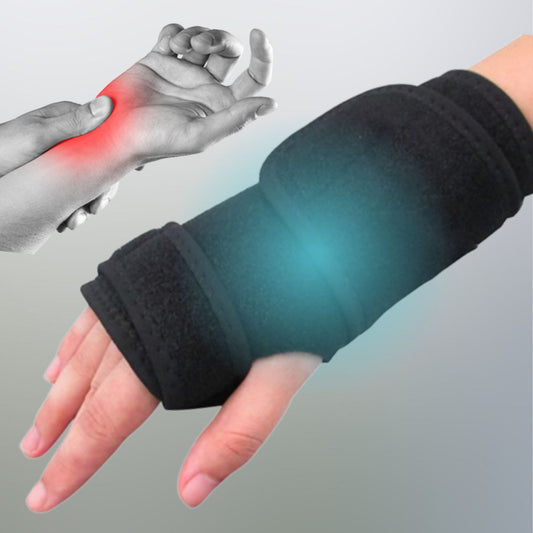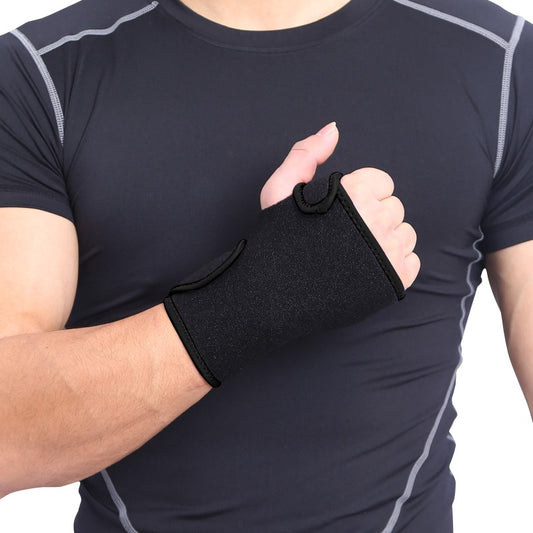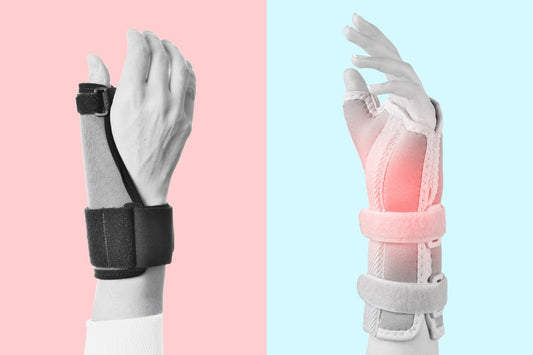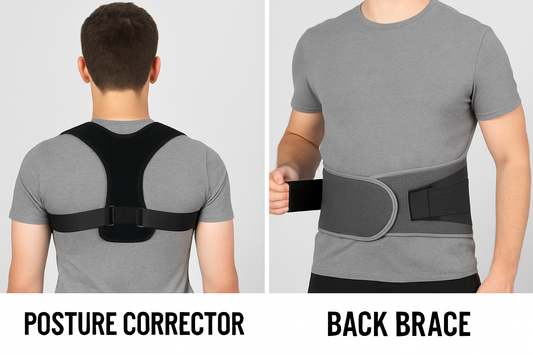Wrist pain can make everyday tasks — typing, lifting, or even sleeping — surprisingly difficult. Two common supports used for relief are wrist braces and wrist splints. At a glance, they might seem the same, but each is designed with a different level of support and purpose in mind.
Are Wrist Braces and Splints the Same Thing?
Not exactly. While both stabilize the wrist, they differ in structure, flexibility, and intended use.
- A wrist brace is flexible and provides adjustable compression, offering mild to moderate support while allowing some wrist motion. It’s ideal for general pain relief, sports, and preventive use.
- A wrist splint, on the other hand, includes a rigid insert or metal stay that keeps the wrist in a fixed position to limit movement entirely. It’s used for recovery after injuries or for conditions that worsen with motion, such as carpal tunnel syndrome.
Think of it this way:
A wrist brace supports your wrist while you move. A wrist splint prevents your wrist from moving so it can heal.
Key Differences: Structure, Support, and Mobility
| Feature | Wrist Brace | Wrist Splint |
|---|---|---|
| Design | Soft, flexible fabric with adjustable straps | Rigid or semi-rigid with metal or plastic stays |
| Support Level | Mild to moderate stabilization | Firm immobilization |
| Mobility | Allows limited movement | Restricts nearly all wrist motion |
| Primary Purpose | Compression, support, and pain relief | Immobilization during injury or recovery |
| Comfort | Lightweight and breathable | Bulkier, may limit hand use |
| Typical Duration | Daily or long-term wear for prevention | Short-term use for acute or medical treatment |
When to Use Each — Wrist Brace vs Splint
Wrist Brace
A wrist brace provides flexible support and gentle compression, helping stabilize tendons and joints without completely restricting motion. It’s typically made from breathable neoprene, elastic fabric, or mesh materials, often with adjustable Velcro straps for customized fit. Because it allows functional movement, it’s suitable for people who still need to use their hands while protecting the wrist.
Ideal for:
- Mild wrist pain or fatigue: Helps ease tension from repetitive use without limiting daily activities.
- Repetitive strain injuries: Common among typists, gamers, or professionals who use tools for long periods.
- Mild carpal tunnel symptoms: Provides light support and compression to reduce tingling or discomfort.
- Athletic support: Often worn by tennis players, golfers, and weightlifters to prevent overextension.
- Daily protection: Useful for people who have weak wrists or experience occasional soreness from work or exercise.
Wrist Splint
A wrist splint is a more rigid form of stabilization, designed to restrict nearly all wrist movement. It usually contains a metal or plastic stay that runs along the underside or back of the wrist to keep it in a neutral position. This immobilization allows injured tissues to heal properly without further strain.
Ideal for:
-
- Carpal tunnel syndrome (moderate to severe): Prevents flexion or bending that worsens nerve compression.
- Fractures or ligament injuries: Keeps the wrist still to promote bone and tissue healing.
- Post-surgery or cast removal: Protects the area during recovery and prevents accidental re-injury.
- Severe sprains: Reduces movement and provides complete rest to the ligaments.
- Night-time use: Commonly worn during sleep to keep the wrist in a neutral position and minimize pain or numbness.
Can They Be Used Interchangeably?
In general, no — because a brace supports movement, while a splint prevents it.
A wrist brace is ideal when some flexibility is beneficial, such as during mild strain recovery or for preventive support. In contrast, a wrist splint is meant for immobilization and is typically used under medical supervision for injuries that need rest and protection.
However, they can complement each other across different recovery stages:
- Early stage: A splint is used first to immobilize the wrist while inflammation and pain subside.
- Later stage: As healing progresses, the splint is replaced with a brace to reintroduce safe movement and build strength.
Using them interchangeably without guidance can be counterproductive:
- Wearing a splint when you only need light support can cause stiffness and weaken muscles.
- Relying on a brace when your wrist needs full immobilization can delay healing or worsen the condition.
In short, both tools play essential roles — but the right one depends on your injury type and stage of recovery.
How to Choose the Right Wrist Support for You
-
Identify your symptoms:
- Dull, mild pain from overuse or daily activity → choose a wrist brace.
- Sharp pain, swelling, or injury requiring rest → opt for a wrist splint.
-
Consider your lifestyle:
- Braces are slim, breathable, and can be worn while typing, working, or exercising.
- Splints are bulkier and best suited for rest, recovery, or sleep.
-
Assess the severity of your condition:
- For mild or recurring strain, a brace can offer the right balance between comfort and support.
- For post-injury or medical conditions (like carpal tunnel or fractures), use a splint for firm stabilization.
-
Follow medical advice:
- If symptoms persist beyond a few days, or if pain worsens, consult a healthcare professional. They may recommend starting with a splint before transitioning to a brace.
The key is to find a balance between support and mobility — protecting your wrist without over-restricting it.
Wrist Brace vs Splint: The Bottom Line
When comparing a wrist brace vs splint, the key difference is support versus immobilization. A wrist brace provides flexible compression and stability for mild pain or repetitive strain, allowing you to stay active while healing. A wrist splint, however, offers firm immobilization for more serious conditions, protecting the wrist and promoting proper recovery.
They aren’t interchangeable but can work hand in hand as part of a recovery plan — starting with a splint to rest the wrist, then transitioning to a brace once movement becomes safe.
Choosing the right one depends on your pain level, activity, and recovery needs. If you’re unsure which device suits your situation, seek professional advice to avoid delaying healing or aggravating the injury. The right support at the right time can make all the difference in restoring comfort, strength, and mobility.


